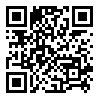Volume 2, Issue 1 (3-2020)
JAD 2020, 2(1): 141-146 |
Back to browse issues page
Download citation:
BibTeX | RIS | EndNote | Medlars | ProCite | Reference Manager | RefWorks
Send citation to:



BibTeX | RIS | EndNote | Medlars | ProCite | Reference Manager | RefWorks
Send citation to:
Abdullah Najim S, Salih AL-Hadlag K. First record of Latrodectus dahli Levi, 1959 (Araneae: Theridiidae) from Iraq. JAD 2020; 2 (1) :141-146
URL: http://jad.lu.ac.ir/article-1-65-en.html
URL: http://jad.lu.ac.ir/article-1-65-en.html
1- Natural History Museum, Basrah University, Basrah, Iraq , shurooq.najim@uobasrah.edu.iq
2- Biology Department, Science College, Basrah University, Basrah, Iraq
2- Biology Department, Science College, Basrah University, Basrah, Iraq
Abstract: (11285 Views)
The widow spider Latrodectus dahli Levi, 1959 is recorded for the first time from Iraq, based on four female specimens collected in Basra Province. There are 32 valid species of the genus Latrodectus with a worldwide distribution. The female copulatory organ is illustrated. Latrodectus dahli is similar to L. hystrix Simon, 1890 in the female internal duct system but differs in the shape and coloration of the opisthosoma. Distribution records now include North Africa, Turkey, Azerbaijan, Kazakhstan, Iran, Central Asia (WSC, 2020), and now Iraq.
Type of Study: Original Research Article |
Subject:
Species Diversity
Received: 2020/03/11 | Accepted: 2020/05/23 | Published: 2020/06/4
Received: 2020/03/11 | Accepted: 2020/05/23 | Published: 2020/06/4
References
1. Al-Khazali, A. M (2018). The first record of family Agelenidae from Iraq (Arachnida: Araneae). Serket, 16 (2): 60–65.
2. Al-Khazali, A. M. and Najim, S. A. (2018). First record of Pholcidae (Arachnida: Araneae) from Iraq. Bulletin of Iraq Natural History Museum, 15 (2): 179–187.
3. Foelix, R. (2010). Biology of spiders. Third Edition. Oxford University Press, Oxford. 432 pp.
4. Fomichev, A. A., Marusik, Y. M. and Koponen, S. (2018). New data on spiders (Arachnida: Araneae) of Iraq. Zoology in the Middle East, 64 (4): 329–339. https://doi.org/10.1080/09397140.2018.1484018 [DOI]
5. Isbister, G. K. and Gray, M. R. (2003). Latrodectism: a prospective cohort study of bites by formally identified redback spiders. The Medical Journal of Australia, 179 (2): 88–91. https://doi.org/10.56941j.1326-5377.tb05641.x [DOI]
6. Jäger, P. and Gromov, A. V. (2011). First Records of Latrodectus dahli Levi, 1959 from Morocco, Turkey, Turkmenistan and the United Arab Emirates. Arachnology, 15 (6): 188–192. https://doi.org/10.13156/arac.2011.15.6.188 [DOI]
7. Knoflach, B. and Harten, A. van. (2002). The genus Latrodectus (Araneae: Theridiidae) from mainland Yemen, the Socotra Archipelago and adjacent countries. Fauna of Arabia, 19: 321–361.
8. Levi, H. W. (1959). The spider genus Latrodectus (Araneae: Theridiidae). Transactions of the American Microscopical Society, 78 (1): 7–43.
9. Lotz, L. N. (1994). The button spiders of southern Africa (Latrodectus: Araneae: Theridiidae). Spider Club News, 9 (3): 9–16.
10. Mirshamsi Kakhki, O. (2005). New records of three Latrodectus species found in Khorasan province (Araneae: Theridiidae). Iranian Journal of Animal Biosystematics (IJAB), 1 (1): 52–58.
11. Platnick, N. I. (2010). The World Spider Catalog. American Museum of Natural History. Version 11.0, online at http//:research.amnh.org/iz/spiders/catalog.
12. Rafinejad, J., Tirgari, S., Biglarian, F. and Shemshad, K. H. (2007). Systematics, bioecology, and medical importance of widow spiders (Latrodectus spp.) in Khorasan Province, Iran. Iranian Journal of Arthropod-Borne Diseases, 1 (1): 52–57.
13. Rahmani, F., Banan Khojasteh, S. M., Ebrahimi Bakhtavar, H., Shahsavari Nia, K., Jafari Roohi, A., Massoud, A., Najafi Fakhrayi, B. and Shahbazi, S. (2014). Identification of widow spiders in East Azerbaijan, Iran: case series. Medical Journal of Tabriz University of Medical Sciences and Health Services, 36 (1): 82–86.
14. Ushkaryov, Y. A., Volynski, K. E. and Ashton, A. C. (2004). The multiple actions of black widow spider toxins and their selective use in neurosecretion studies. Toxicon, 43 (5): 527–542. https://doi.org/10.1016/j.toxicon.2004.02.008 [DOI]
15. WSC (World Spider Catalog) (2020). World Spider Catalog. Version 21.0. Natural History Museum Bern. http://wsc.nmbe.ch (Accessed on 23 May 2020). https://doi.org/10.24436/2 [DOI]
16. Zamani, A. and El-Hennawy, H. K. (2016). Preliminary list of the spiders of Iraq (Arachnida: Araneae). Arachnida – Rivista Aracnologica Italiana, 6: 12–20.
17. Zamani, A., Mirshamsi, O., Savoji, A. and Shahi, M. (2014). Contribution to the distribution of spiders with significant medical importance (Araneae: Loxosceles and Latrodectus) in Iran, with a new record for the country. Iranian Journal of Animal Biosystematics (IJAB), 10 (1): 57–66.
Send email to the article author
| Rights and permissions | |
 |
This work is licensed under a Creative Commons Attribution-NonCommercial 4.0 International License. |








